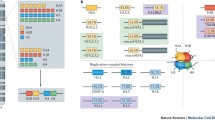Abstract
Histones are the major protein constituents of the chromatin of eukaryotic cell nuclei. This group of basic proteins is extremely conserved throughout evolution and includes five classes termed H1, H2A, H2B, H3and H4. In mammals, each of these classes except H4 is subdivided into several subtypes. The most divergent class of histones is the H1 protein family, which consists of seven different subtypes, termed H1.1–H1.5, H1°, and H1t. The subtypes H1.2 and H1.4 are found in most somatic cell nuclei, whereas H1° is found in several differentiated tissues, and H1t is restricted to mammalian testicular cells. Similarly, core histone subtypes replacing the major forms of H2A, H2B or H3 have been described. Biochemical analysis of protein and RNA from different tissues and cell lines demonstrates varied patterns of expression of individual histone subtype genes. Moreover, antibodies against specific histone subtypes and in situ hybridization with subtype-specific probes indicate that the expression of histone subtype genes is in several cases modulated in a tissue-specific manner. This is particularly evident at the different stages of spermatogenesis when chromatin undergoes substantial reorganization, which finally results in the highly condensed state of chromatin of the mature sperm head.
Similar content being viewed by others
Author information
Authors and Affiliations
Additional information
Accepted: 30 September 1996
Rights and permissions
About this article
Cite this article
Doenecke, D., Albig, W., Bode, C. et al. Histones: genetic diversity and tissue-specific gene expression. Histochemistry 107, 1–10 (1997). https://doi.org/10.1007/s004180050083
Issue Date:
DOI: https://doi.org/10.1007/s004180050083




